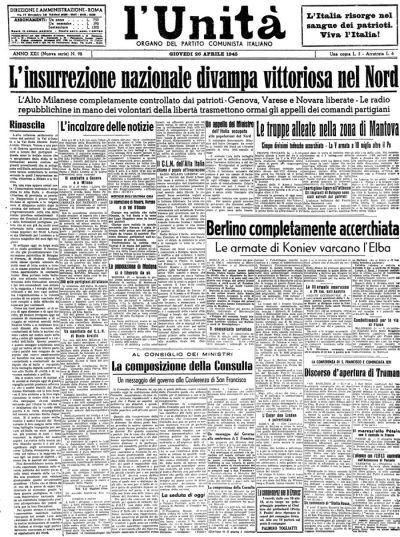Loading player
Liberation Day from Nazi-Fascism is celebrated on 25 April in Italy. The German and fascist occupation in Italy did not end in a single day, but April 25th is considered a symbolic date because in 1945 it coincided with the beginning of the retreat by the soldiers of Nazi Germany and the fascist soldiers of the Republic of Salò from the cities of Turin and Milan, after the population had rebelled and the partisans had organized a coordinated plan to regain control of the cities.
The decision to choose 25 April as “Liberation Day” (or as the “anniversary of the Liberation of Italy”) was taken on 22 April 1946, when the provisional Italian government – the first led by Alcide De Gasperi and the last of the Kingdom of Italy – established with a decree that 25 April should be a “national holiday”.
The date was definitively set with law no. 269 of May 1949, presented by De Gasperi in the Senate in September 1948. Since then, 25 April has been a public holiday, like Sundays, 1 May, Christmas Day and Republic Day, which occurs on 2 June. The war in Italy did not end on April 25, 1945, however: it continued for a few more days, until the beginning of May.
– Read also: April 25 explained by Makkox
Other European countries also remember the end of foreign occupation during the Second World War, but on different dates: the Netherlands and Denmark celebrate it on 5 May, Norway on 8 May, Romania on 23 August. Liberation Day is also celebrated in Ethiopia on May 5th, but in that case to remember the end of the Italian occupation, which occurred in 1941.
What happened before April 25th
In the first months of 1945 there were several tens of thousands of people, mostly partisans, fighting against the German occupation and the republic of Salò in northern Italy, with a fair amount of organization from a military point of view.
To the south of the Po Valley in March 1945 there were many occupying soldiers trying to resist the final offensive of the Allies, which intensified starting from 9 April (in an area east of Bologna) along a more or less parallel front to Via Emilia. The offensive was immediately a success, both due to the superiority of men and equipment of the attackers and the general feeling of distrust and inevitability of defeat that had spread among the German soldiers and the republicans, despite the wishes of the highest German and fascist authorities to continue the war to the end.
On April 10, the Communist Party disseminated “Directive no.” to all local organizations with which it was in contact. 16”, in which it was said that the time had come to “unleash the definitive attack”; six days later the CLNAI (Committee of National Liberation of Northern Italy, which included all the Italian anti-fascist and resistance movements, from the communists to the socialists to the Christian Democrats and the shareholders, i.e. the members of the Action Party) issued similar insurrection instructions general. The partisans organized and launched attacks on urban centers. Bologna, for example, was attacked by partisans on April 19th and finally liberated with the help of the allies on the 21st.
On 24 April 1945 the allies crossed the Po, and on 25 April the German soldiers and those of the Republic of Salò began to withdraw from Milan and Turin. In Milan, starting from the morning of the previous day, a general strike had been proclaimed, announced on the “Milano Libera” radio by Sandro Pertini, future President of the Republic, then a partisan and member of the National Liberation Committee (CLN).
The factories were occupied and garrisoned and the printing press of Corriere della Sera it was used to print the first sheets announcing the victory. On the evening of April 25th Benito Mussolini abandoned Milan to go towards Como (he would later be captured by the partisans two days later and killed on April 28th).
The partisans continued to arrive in Milan in the days between the 25th and 28th, defeating the residual and limited resistance. A large demonstration to celebrate the liberation was held in Milan on 28 April. The Americans arrived in the city on May 1st.

The Allied offensive in Northern Italy in the spring of 1945 (Wikipedia)
The front pages of newspapers on April 25, 1945
Italian newspapers celebrated April 25, 1945 as an important day in the war: not only that the Unity And The peopleofficial newspapers of the Communist Party and the Christian Democrats that were printed in the parts of Italy that had already been liberated some time ago, but also the Corriere della Serawho had been close to the regime during the twenty years of fascism.

On April 26th Courier came out with a sort of “single issue” with the header The New Courier: the director of the edition was Mario Borsa, an anti-fascist journalist to whom the CLN temporarily entrusted the direction of the newspaper. Only the front page headlines of Press of April 26 completely ignored the fighting in northern Italy: they spoke instead of the “fanatical resistance” of the German soldiers in Germany, who now controlled only a few neighborhoods of Berlin.






